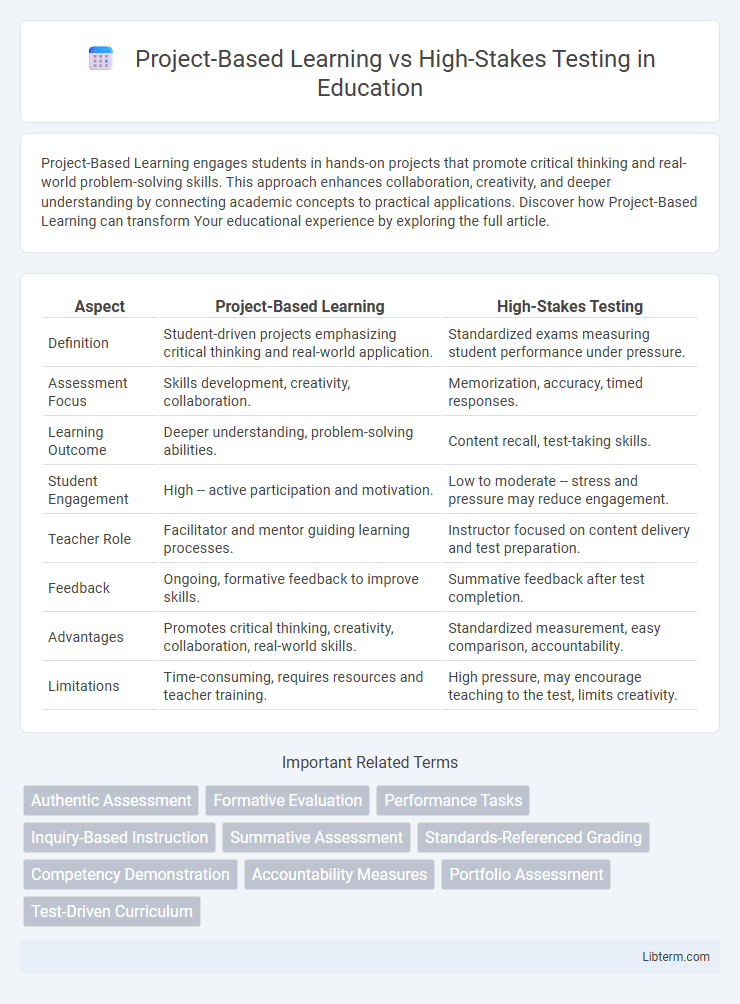Project-Based Learning engages students in hands-on projects that promote critical thinking and real-world problem-solving skills. This approach enhances collaboration, creativity, and deeper understanding by connecting academic concepts to practical applications. Discover how Project-Based Learning can transform Your educational experience by exploring the full article.
Table of Comparison
| Aspect | Project-Based Learning | High-Stakes Testing |
|---|---|---|
| Definition | Student-driven projects emphasizing critical thinking and real-world application. | Standardized exams measuring student performance under pressure. |
| Assessment Focus | Skills development, creativity, collaboration. | Memorization, accuracy, timed responses. |
| Learning Outcome | Deeper understanding, problem-solving abilities. | Content recall, test-taking skills. |
| Student Engagement | High -- active participation and motivation. | Low to moderate -- stress and pressure may reduce engagement. |
| Teacher Role | Facilitator and mentor guiding learning processes. | Instructor focused on content delivery and test preparation. |
| Feedback | Ongoing, formative feedback to improve skills. | Summative feedback after test completion. |
| Advantages | Promotes critical thinking, creativity, collaboration, real-world skills. | Standardized measurement, easy comparison, accountability. |
| Limitations | Time-consuming, requires resources and teacher training. | High pressure, may encourage teaching to the test, limits creativity. |
Introduction: Project-Based Learning vs High-Stakes Testing
Project-Based Learning (PBL) fosters critical thinking, creativity, and real-world problem-solving by engaging students in hands-on, collaborative projects. High-Stakes Testing emphasizes standardized assessment performance, often prioritizing memorization and test-taking strategies over deeper understanding. Comparing these educational approaches reveals significant differences in student engagement, skill development, and long-term academic success.
Defining Project-Based Learning
Project-Based Learning (PBL) is an instructional methodology where students actively explore real-world problems and challenges through extended projects, fostering critical thinking, collaboration, and practical application of knowledge. Unlike traditional testing methods, PBL emphasizes deeper understanding and skill development by engaging learners in meaningful tasks aligned with curriculum standards. This approach promotes retention and transfer of knowledge, preparing students for complex future challenges rather than focusing solely on performance in high-stakes assessments.
Understanding High-Stakes Testing
High-stakes testing measures student performance through standardized exams that influence academic progression, school funding, and teacher evaluation, often prioritizing rote memorization over critical thinking skills. These tests can induce significant stress and may narrow curricula, as educators focus on test preparation rather than holistic learning. Understanding the limitations of high-stakes testing highlights the need for alternative assessments that promote deep comprehension and real-world problem-solving.
Core Principles and Pedagogies Compared
Project-Based Learning emphasizes student-driven inquiry, collaboration, and real-world problem-solving, fostering deeper understanding through hands-on experiences aligned with constructivist pedagogy. High-Stakes Testing centers on standardized assessments designed to measure knowledge retention and performance under pressure, often promoting rote memorization and teacher-directed instruction. The core principles differ as Project-Based Learning nurtures critical thinking and creativity, while High-Stakes Testing prioritizes accountability and benchmark comparisons within rigid curriculum frameworks.
Impact on Student Engagement and Motivation
Project-based learning significantly increases student engagement and motivation by fostering hands-on, meaningful experiences that connect academic content to real-world applications. In contrast, high-stakes testing often undermines motivation by emphasizing rote memorization and performance pressure, leading to anxiety and disengagement. Research shows that students involved in project-based learning demonstrate higher intrinsic motivation and sustained interest compared to those subjected primarily to standardized testing environments.
Assessing Critical Thinking and Problem-Solving Skills
Project-Based Learning (PBL) enhances the assessment of critical thinking and problem-solving skills by engaging students in complex, real-world challenges that require analysis, collaboration, and creative decision-making. High-stakes testing predominantly measures rote memorization and standardized knowledge, offering limited insight into students' abilities to apply concepts or innovate under pressure. Empirical studies show that PBL fosters deeper cognitive skills and adaptive expertise, which are crucial for success in dynamic, real-world environments.
Measuring Academic Achievement: Qualitative vs Quantitative
Project-Based Learning emphasizes qualitative assessment by evaluating students through portfolios, presentations, and real-world problem-solving, capturing deeper understanding and critical thinking skills. High-Stakes Testing relies on quantitative metrics, using standardized test scores to measure academic achievement objectively and compare performance across populations. The qualitative nature of Project-Based Learning provides rich, contextual insights, while High-Stakes Testing offers precise, statistics-driven accountability.
Teacher Roles and Classroom Dynamics
Project-Based Learning empowers teachers to act as facilitators and coaches, guiding students through hands-on, collaborative problem-solving experiences that promote critical thinking and creativity. In contrast, High-Stakes Testing positions teachers as content deliverers focused on test preparation, often limiting instructional flexibility and reducing opportunities for personalized student engagement. Classroom dynamics in Project-Based Learning are characterized by student-centered exploration and peer interaction, whereas High-Stakes Testing environments tend to emphasize individual performance and standardized assessment protocols.
Preparing Students for Future Success
Project-Based Learning (PBL) emphasizes critical thinking, collaboration, and real-world problem-solving skills that align with future workforce demands, fostering deeper understanding through hands-on experiences. High-Stakes Testing primarily measures rote memorization and standardized knowledge, which may not adequately prepare students for dynamic, interdisciplinary challenges in modern careers. Evidence from educational research highlights that PBL cultivates adaptability and innovative thinking, key competencies for long-term success beyond academic environments.
Choosing the Best Approach for Diverse Learners
Project-Based Learning promotes active engagement and critical thinking by allowing diverse learners to apply knowledge through real-world problems, enhancing retention and adaptability. High-Stakes Testing primarily measures standardized knowledge and can cause stress, potentially disadvantaging students with different learning styles or backgrounds. Selecting the best approach involves balancing the depth of understanding from project-based experiences with the accountability and benchmarking provided by standardized tests to meet varied learner needs effectively.
Project-Based Learning Infographic

 libterm.com
libterm.com